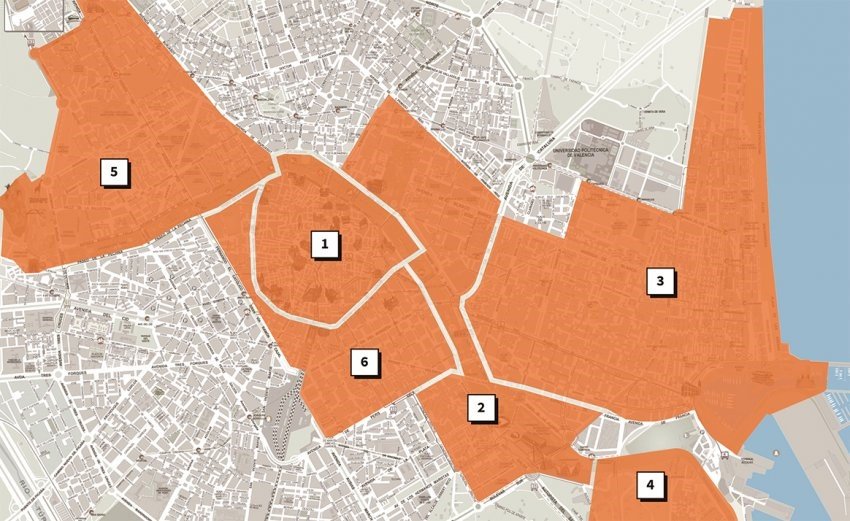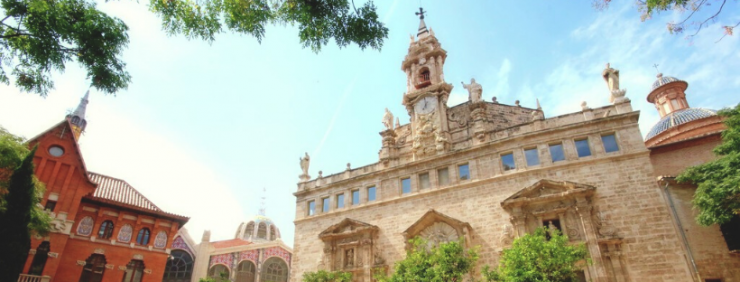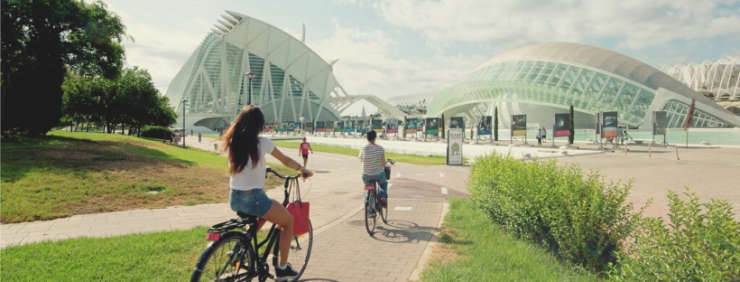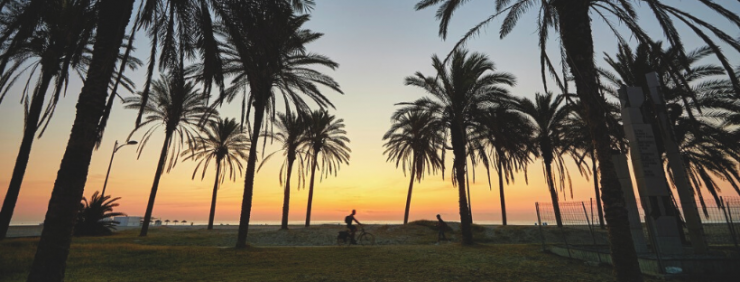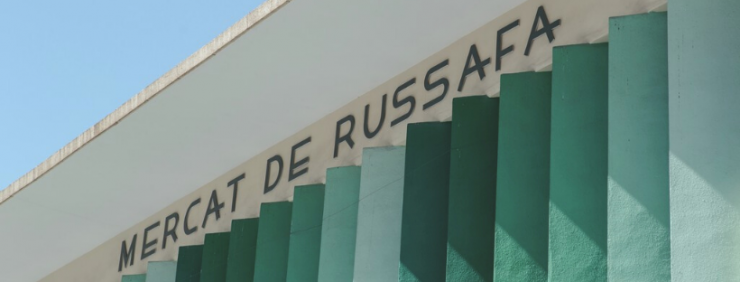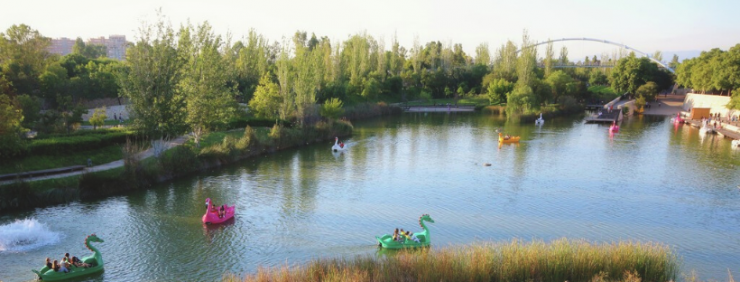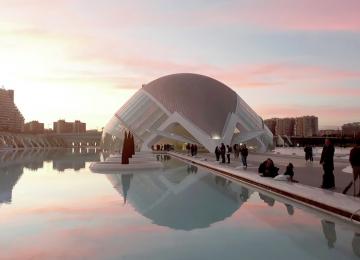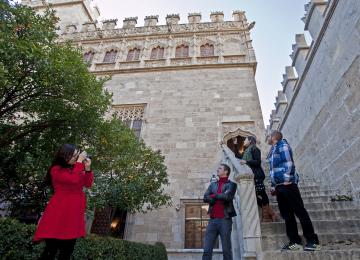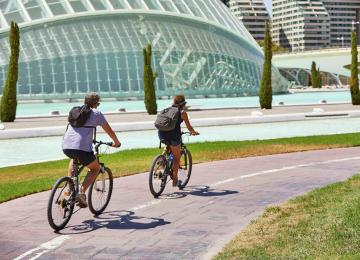Take a leisurely walk, rediscover Valencia and fall in love with the city
The best routes to walk in Valencia by foot
"The world is falling apart and we are falling in love"... It is one of the most mythical reunions in the history of cinema, Casablanca. We want your return to Valencia to be among those who make history. Endless gardens, sunny squares with terraces, Mediterranean streets, large avenues, long sandy beaches, Gothic, Baroque and Art Nouveau facades, futuristic open spaces and a thousand small details that sometimes go unnoticed in the rush... Valencia is in ON mode. What are you waiting for to re-enter its history? Or the beach? Or the green of its gardens? Put on comfortable shoes and get ready to rediscover the city by walking from quarter to quarter, because... "we will always have Valencia".
To make your visits easier, here is a guide to the most outstanding areas of the city, organized around 5 areas so that you can plan your time and enjoy the walk.
Have a look at the map for a complete experience
1. Historical centre: 2,000 years of history for your eyes
Whether you have walked through it a thousand times or for the first time, the centre of Valencia has so much cultural heritage that you will be surprised, and much of it is in its streets and in front of its buildings, waiting for you to notice and discover it. Valencia has one of the largest historic city centres in Europe. It has such beautiful buildings as La Lonja de la Seda, (Silk Exchange) a treasure of civil Gothic inside and out. Have you ever stopped to look at its gargoyles? They are figures in 'strange' poses. Make a stop; they will surprise you.
Directly opposite, from another imposing architecture, that of the Mercado Central in Art Nouveau style, there are two figures that could very well be talking to their neighbouring gargoyles. The dome, which reaches a height of 30 metres, is crowned by a weathervane in the shape of a parrot and another in the shape of a fish. It is said that the first one has a suitor whom he ignores. The Pardalot (bird) watches him from the nearby Santos Juanes church, while the parrot turns with the wind and looks in all directions.
The construction of the entrances to Valencia Cathedral in turn allows us to see three different styles without even entering the cathedral. The Romanesque Puerta de l'Almoina, the Gothic Puerta de los Apóstoles and the Baroque Puerta de los Hierros - a whole journey through art history, just by walking around this church! The Tribunal de las Aguas (Water Tribunal) is held weekly in the church of the Apostles and in the Romanesque church there are 14 heads carved on the arches: Who are they? Seven couples who came to Valencia from Lleida after the reconquest of the city to populate it, with their respective names carved in the stone.
Another interesting point of the walk is the Plaza de la Virgen, where you should definitely stop to admire the fountain, a true icon of the city. Did you know that the figure of the Baron represents the River Turia? Yes, it is not Neptune, the sea god, and the women around him are the eight irrigation channels of the Turia: Rovella, Rascanya, Favara, Quart, Tormos, Benager, Faitanar, Mislata and Mestalla, with names of Arabic origin. Valencia, the orchard and the water, always in step.
These are just a few points to stop at, because there are many more. The Serranos Towers, once a prison, and the Quart Towers, Plaza Redonda, the Barrio del Carmen quarter or Plaza de la Almoina, above the old Roman forum, are places you will fall in love with. The list is almost endless.
2. Turia garden: 9 green, tree-covered and futuristic kilometres
This wide and landscaped area will also make you fall in love with Valencia and its greens. Ideal for walking or cycling. The Jardín del Turia Park, a space won for the city after the river was diverted because of the floods, is the best place for leisure, sports, recreation and quiet walks at any time of day. With the vegetation typical of the area, palm trees, orange trees, mulberry trees, roses, aromatic plants, ponds and fountains, it is also crowned by 18 bridges of different styles that lead from Parque de Cabecera to the sea: the Puente del 9 de Octubre (10th century), Campanar (20th century), Ademúz (20th century), de las Artes (20th century), San José (17th century), Serranos ((16th century), Madera (21st century), De la Trinidad (15th century), del Real (16th century), de la Exposición (21st century), De las Flores (21st century), del Mar (16th century), Aragón (20th century), Ángel Custodio (20th century), Reino (20th century), Monteolivete (21st century), Assut d’Or (21st century), and Astilleros (20th century). It is worth stopping to look at these pedestrian bridges, which are a symbol of communication, ancient routes for trade and people and today a reflection of the past and present. Along this route you will walk among buildings that date from the XVth to the XXIth century.
This journey through time will take you into the future. A city that Disney used as the backdrop for the film Tomorrowland and which is always worth a snapshot.
In the Ciutat de les Arts i les Ciències, in addition to the imposing buildings of the Hemisfèric, the Palau de les Arts, the Museu de les Ciències, the Agora and the Oceanogràfic, there are numerous ways to observe the local flora, or it is also pleasant to walk to the Umbracle, a lookout point at over 17,000 metres of urban area, with an open-air exhibition area that offers a wonderful panorama of the entire complex.
In the Jardín del Turia Park you will find other interesting places, such as the Palau de la Música and the Paseo de la Alameda, and on one of its banks, a huge avenue of century-old ficus trees, terraces and restaurants, very close to the Viveros and Monforte Parks. These are open air spaces where you can breathe in an atmosphere of romance.
DISCOVER THE ALAMEDA, THE CIUTAT DE LES ARTS AND THE OCEANOGRÀFIC
3. Breathe and enjoy its light: you at the mediterranean
Sometimes, stress makes us forget about it, but for a good walk you only need the right environment, and this is a picture. Wide spaces to walk, long yellow sand beaches, establishments with immense terraces and all the charm of the narrow streets of the old fishermen's quarters. We enter the area of the city where Sorolla painted scenes in the open air, under a redeeming light, of children playing in calm blue waters and women walking around with white umbrellas and linen suits. The surroundings have changed since then, but not the light and the Mediterranean, what more do you need for a good walk?
But that's not all: in front of Malvarrosa beach is the Marina de València, an ideal area for walking, roller-skating or cycling, with its wide esplanades and landscaped areas. At the Marina In it, the Veles e Vents building stands out, named after a poem by the Valencian writer Ausiàs March. It was designed by David Chipperfield and Fermín Vázquez to welcome the guests of the America's Cup. Its design is spectacular, and it is a good place to enjoy a panoramic view of the dock.
Behind it is the Malvarrosa beach and the Paseo de Neptuno with its cheerful terraces; and behind it the fashionable district, the Cabanyal. A place that has preserved all the charm of times gone by, with narrow streets full of Art Nouveau buildings. Cheerful two-storey houses with ceramic facades in the typical colours of the time, blue, white and green.
This quarter is spacious and the promenade can be extended along the beach of La Patacona. Usually, this whole route offers a wide range of leisure and restoration activities and a variety of nautical activities. A swim on the beach, a bike ride, tasting the authentic Valencian paella or the atmosphere of the terraces by the sea is always a good complement to the walk.
DISCOVER THE MARINA, THE BEACHES AND THE CABAÑAL DISTRICT
4. A cosmopolitan walk through the valencian art nouveau
If you have already been to the historic centre, the modernism route also has many recommended places. With wide pavements and full of stately buildings and modernist palaces, the Ensanche district is another ideal place for a walk and to stop off at one of its terraces. The façades of streets such as Don Juan de Austria, Sorní, Cirilo Amorós or Conde Salvatierra are enough to delight the eye, but there are also other more monumental buildings in this area that architecturally attract a lot of attention just by looking at them from the outside. These are the Estación del Norte (North Railway Station) with its Art Nouveau mosaics; the Plaza del Ayuntamiento, now a pedestrian square; the Baroque façade of the Palacio del Marqués de Dos Aguas with the figures of the Turia and Júcar rivers on either side of the entrance; the Mercado de Colón, also in Art Nouveau style with the lively atmosphere that surrounds it; or the Plaza del Patriarca and Calle de la Paz, one of the streets that still has the most modernist buildings.
On the other side of Gran Vía, the Ruzafa district awaits you. This bustling quarter, also with wide sidewalks, known to many people as the "Soho" of Valencia, with a lot of life around its market and art nouveau palaces, has attracted a large number of restaurants and bars in recent years.
Just a hop, skip and a jump away is Parque Central, a garden of more than 100,000 square metres that has gained ground opposite the old railway tracks and now houses more than 1,000 trees, ponds, playgrounds and old restored industrial buildings. A highly recommended place for a quiet walk.
DISCOVER THE ENSANCHE AND RUZAFA DISTRICTS
5. Another luxury: a green park in the city's west
After the Jardin del Turia Park to the west, at the opposite end of the Ciutat de les Arts les Ciències, there is another of the best places to walk in the city, the Parc de Cabecera. From here you have access to the Bioparc, a piece of Africa nestled in a 21st century city like Valencia. The park surrounding this Cabecera Park also contrasts with the hustle and bustle of a big city. Large gardens and groves, paths for walking and cycling or a pond with boats, surrounded by native flora. It is the perfect place to relax. Make a detour and discover it!
DISCOVER THE BIOPARK AND THE PARQUE DE CABECERA


